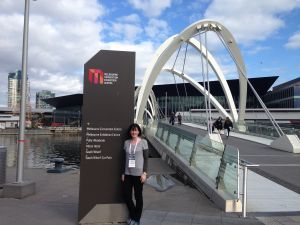Asia–Pacific Prostate Cancer Conference – Insights and best practices from Down Under

It has become a tradition for me to regularly attend the Asia–Pacific Prostate Cancer Conference since my advanced nursing practice focuses mainly on prostate cancer and this multidisciplinary meeting consistently ticks all the boxes for updating knowledge from medical, nursing, allied health, general practice and translational science fields.
I was fortunate to be a participant in the 2016 meeting, which ran from 31 August to 3 September at the Melbourne Convention and Exhibition Centre on the banks of the Yarra River. This wonderful venue was ideal for the plenary sessions, breakout ‘stream’ presentations, workshops and trade displays, all housed conveniently in a bright and airy space. The riverside, central city location offered wonderful walking and cycling routes, as well as renowned shopping spots and restaurants to visit during education down-times. This year’s conference programme once again reinforced the expert opinion and evidence that underpin our local practices, as well as giving me a preview of emerging technologies and scientific breakthroughs. Let me summarise some of the thought-provoking sessions I attended.

Sue at the Convention Centre in Melbourne
Canadian urologist Dr Robert Nam presented a provocative session outlining a pilot study at his centre examining whether MRI is feasible as a prostate cancer screening test. The clinical trial was advertised in a Toronto newspaper for a week which surprisingly elicited 300 responses for only 50 places in the study. Dr. Nam commented that the protocol was attractive to men as it included a free MRI to screen for prostate cancer. The potential downside was the requirement to proceed to prostate biopsy regardless of the MRI findings, but this did not seem to be a big deterrent to recruitment.
During the study each man underwent a PSA test, digital rectal examination, 3-T multiparametric MRI and finally a prostate biopsy. The pilot study results observed that MRI was nearly three times better than PSA at diagnosing prostate cancer. It also performed better at predicting aggressive prostate cancer (Gleason 7 / ISUP 2 or above). Inter-observer variability in interpreting MRI scans was noted to be a potential weakness of this screening approach. The pilot study results were however adequate enough to prompt the research team to roll-out the first randomised clinical trial of MRI versus PSA for prostate cancer screening in a general population.
Sessions on MRI studies
In a further MRI-focussed session UCLA Urologist Dr. Rob Reiter asked if prostate biopsies were really needed in men with an elevated PSA but negative multiparametric MRI scan result. He reported that MRI will miss 20% of Gleason 4+5 (ISUP 5) lesions if they are small, so there is a risk that a negative MRI scan could falsely reassure a man whose prostate harbours a potentially life threatening cancer. He stated that where clinical suspicion remains due to elevated PSA velocity and density, a prostate biopsy should always proceed. Dr. Reiter went on to advocate the usefulness of MRI in selecting active surveillance patients, stating that a negative MRI together with low-risk prostate biopsy features significantly reduces the likelihood of missing a significant prostate cancer.
With New Zealand having recently acquired our first 68Ga-PSMA scanner, I was particularly interested in sessions that explored how this imaging modality is influencing clinical practice overseas. The conference programme included many sessions focussed on the clinical relevance of PSMA scans in evaluating high-risk prostate cancer patients prior to treatment choice, as well as for men with biochemical failure following primary treatment, and in assessing disease burden and treatment response in castrate resistant prostate cancer. This relatively new modality brings promise in all of these scenarios, but the need for clinical trials to evaluate clinical outcomes was stressed throughout the meeting.
Belgian Prof. Bertrand Tombal presented an excellent summary session entitled ‘Evaluating new imaging in prostate cancer’. He noted that clinicians are looking for imaging modalities that offer improved diagnostic accuracy and assessment of treatment response. He stated that the ideal imaging technique would have high diagnostic value, be reproducible, affordable, minimise radiation exposure, be ‘one step’, with high efficacy for monitoring treatment response. He stated that the individual benefit of imaging will be influenced by an assessment of the modalities negative predictive value- that is, those patients you don’t treat who should have been treated -and its positive predictive value- that is, those patients you treat for no benefit. In this context while he noted that 68Ga- PSMA scan is a significant advance on the traditional CT and bone scan imaging modalities, the technique still appears to miss approximately 20% of prostate cancer lesions, leaving clinicians with many difficult patient-focussed questions to answer.
The nursing programme was again excellent in its diversity and calibre of speakers. There were many highlights to share from this interesting stream, so I have written a further column to be included in a future edition of this newspaper. Needless to say I returned home with revitalised passion for our
speciality, feeling rested from the break away from daily routines, in a city that offers so much to see and do. I would like to acknowledge the Prostate Cancer Foundation of New Zealand for their educational scholarship facilitating my attendance and to the conference organisers for an excellent event. I am sure I will be back!
Sue Osborne, Urology Nurse, Auckland (NZ), sue.osborne@waitematadhb.govt.nz

